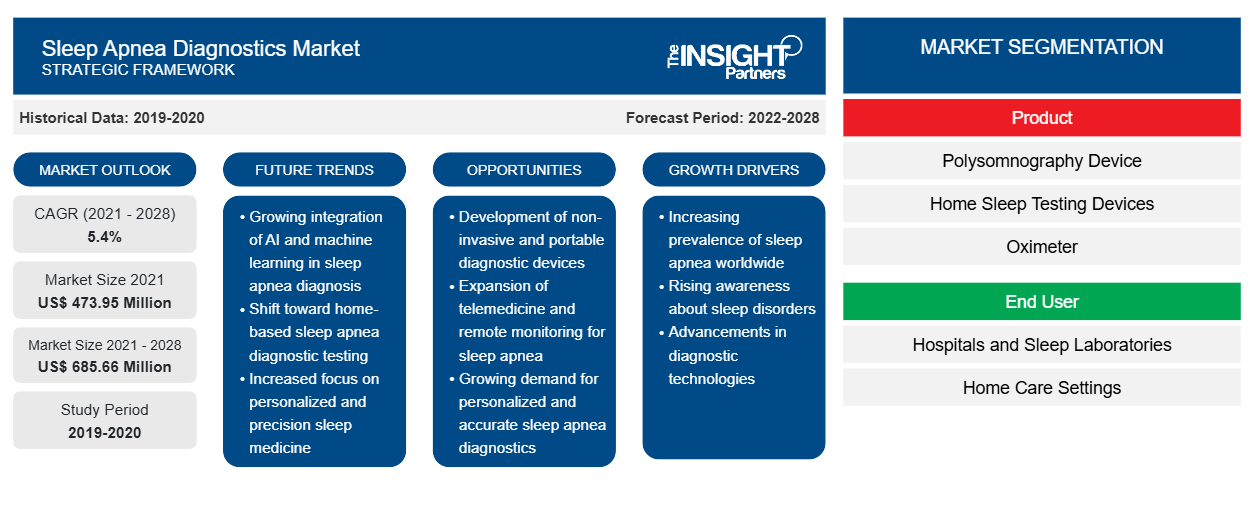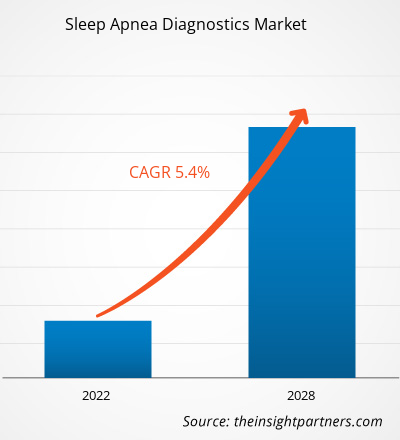Se proyecta que el mercado de diagnóstico de la apnea del sueño alcance los 685,66 millones de dólares en 2028, desde los 473,95 millones de dólares en 2021; se estima que crecerá a una CAGR del 5,4 % entre 2021 y 2028.
La apnea del sueño es un tipo común de trastorno del sueño que se produce cuando una persona tiene dificultad para respirar durante el sueño, con interrupciones y reinicios repetidos. Los dispositivos para la apnea del sueño se utilizan principalmente como dispositivos diagnósticos y terapéuticos para tratar el síndrome de apnea obstructiva del sueño, el síndrome de apnea central del sueño y el síndrome de apnea del sueño complejo. La presión positiva continua en las vías respiratorias es un dispositivo ampliamente recomendado para tratar la apnea obstructiva del sueño.
Factores como el aumento de la prevalencia de la apnea del sueño, los avances tecnológicos y el aumento de la población geriátrica impulsan el crecimiento del mercado de diagnóstico de la apnea del sueño . Sin embargo, el alto costo del diagnóstico y los desafíos en la industria de dispositivos médicos frenan el crecimiento del mercado.
Recibirá personalización de cualquier informe, sin cargo, incluidas partes de este informe o análisis a nivel de país, paquete de datos de Excel, así como también grandes ofertas y descuentos para empresas emergentes y universidades.
Mercado de diagnóstico de la apnea del sueño: Perspectivas estratégicas

-
Obtenga las principales tendencias clave del mercado de este informe.Esta muestra GRATUITA incluirá análisis de datos, desde tendencias del mercado hasta estimaciones y pronósticos.
Perspectivas del mercado
El aumento de la prevalencia de la apnea del sueño impulsa el crecimiento del mercado de diagnóstico de la apnea del sueño.
La apnea obstructiva del sueño (AOS) es un trastorno común que se caracteriza por el cierre repetitivo, completo o parcial, de la vía aérea superior durante el sueño. Esta vía aérea contribuye a la fragmentación del sueño y la desaturación de oxígeno. Este trastorno causa una morbilidad significativa, especialmente en forma de deterioro del funcionamiento diurno y una calidad de vida degradada. Según estudios controlados recientes, los dispositivos bucales tienen una eficacia de hasta el 50 % en el control de la AOS en pacientes, incluso en casos graves.
Según una encuesta realizada por Needham & Company, una firma de inversión, más de un tercio de las pruebas de AOS se realizaron en los hogares de los pacientes en 2018, un aumento con respecto al 15% en 2013. Como resultado, las empresas están centrando sus esfuerzos en el desarrollo de equipos para la apnea del sueño en el hogar. En junio de 2019, la FDA aprobó a Itamar Medical, una empresa con sede en Israel, una prueba desechable para la apnea del sueño en el hogar. ResApp (Australia), una empresa que desarrolla aplicaciones para teléfonos inteligentes para el diagnóstico y el tratamiento de trastornos respiratorios, ha lanzado SleepCheck, una aplicación de detección de AOS en el hogar.
Debido al creciente uso del dispositivo de polisomnografía (PSG) en varias regiones, la necesidad de dispositivos de PSG mejorados y tecnológicamente avanzados para el diagnóstico de AOS ha aumentado sustancialmente, impulsando así el mercado mundial de diagnóstico de apnea del sueño.
Perspectivas basadas en productos y servicios
Según el producto, el mercado de diagnóstico de la apnea del sueño se segmenta en dispositivos de polisomnografía (PSG), dispositivos de prueba del sueño para el hogar, oxímetros, dispositivos de monitoreo de actigrafía y dispositivos de detección de la apnea del sueño. El segmento de oxímetros se segmenta a su vez en oxímetros de dedo, oxímetros de mano, oxímetros de muñeca y oxímetros de sobremesa. Se espera que el segmento de dispositivos de PSG ocupe la mayor cuota de mercado en 2021 y registre la tasa de crecimiento anual compuesta (TCAC) más alta durante el período de pronóstico.
Información basada en el usuario final
Según el usuario final, el mercado de diagnóstico de la apnea del sueño se segmenta en hospitales y laboratorios del sueño, y centros de atención domiciliaria. Se prevé que estos últimos tengan una mayor cuota de mercado en 2021, mientras que se prevé que el segmento de centros de atención domiciliaria registre una mayor tasa de crecimiento anual compuesta (TCAC) durante el período de pronóstico.
Varias empresas que operan en el mercado de diagnóstico de la apnea del sueño están adoptando estrategias como lanzamientos de productos, fusiones y adquisiciones, colaboraciones, innovaciones de productos y expansiones de carteras de productos para expandir su presencia en todo el mundo, mantener la marca y satisfacer la creciente demanda de los usuarios finales.
Perspectivas regionales del mercado de diagnóstico de la apnea del sueño
Los analistas de The Insight Partners han explicado detalladamente las tendencias y los factores regionales que influyen en el mercado del diagnóstico de la apnea del sueño durante el período de pronóstico. Esta sección también analiza los segmentos y la geografía del mercado del diagnóstico de la apnea del sueño en América del Norte, Europa, Asia Pacífico, Oriente Medio y África, y América del Sur y Central.
Alcance del informe de mercado sobre el diagnóstico de la apnea del sueño
| Atributo del informe | Detalles |
|---|---|
| Tamaño del mercado en 2021 | US$ 473,95 millones |
| Tamaño del mercado en 2028 | US$ 685,66 millones |
| CAGR global (2021-2028) | 5,4% |
| Datos históricos | 2019-2020 |
| Período de pronóstico | 2022-2028 |
| Segmentos cubiertos |
Por producto
|
| Regiones y países cubiertos |
América del norte
|
| Líderes del mercado y perfiles de empresas clave |
|
Densidad de actores del mercado de diagnóstico de la apnea del sueño: comprensión de su impacto en la dinámica empresarial
El mercado del diagnóstico de la apnea del sueño está en rápido crecimiento, impulsado por la creciente demanda del usuario final debido a factores como la evolución de las preferencias del consumidor, los avances tecnológicos y un mayor conocimiento de los beneficios del producto. A medida que aumenta la demanda, las empresas amplían su oferta, innovan para satisfacer las necesidades del consumidor y aprovechan las tendencias emergentes, lo que impulsa aún más el crecimiento del mercado.

- Obtenga una descripción general de los principales actores clave del mercado de diagnóstico de la apnea del sueño
Mercado de la apnea del sueño: por producto
- Dispositivo de polisomnografía (PSG)
- Dispositivos de prueba del sueño en casa
-
Oxímetro
- Oxímetro de dedo
- oxímetro de mano
- Oxímetro de muñeca
- Oxímetro de sobremesa
- Dispositivo de monitoreo de actigrafía
- Dispositivo de detección de apnea del sueño
Mercado de diagnóstico de la apnea del sueño: por usuario final
- Hospitales y laboratorios del sueño
- Entornos de atención domiciliaria
Mercado de diagnóstico de la apnea del sueño por geografía
-
América del norte
- A NOSOTROS
- Canadá
- México
-
Europa
- Francia
- Alemania
- Italia
- Reino Unido
- España
- Resto de Europa
-
Asia Pacífico (APAC)
- Porcelana
- India
- Corea del Sur
- Japón
- Australia
- Resto de Asia Pacífico
-
Oriente Medio y África (MEA)
- Sudáfrica
- Arabia Saudita
- Emiratos Árabes Unidos
- Resto de Oriente Medio y África
-
América del Sur (SAM)
- Brasil
- Argentina
- Resto de América del Sur y Central
Perfiles de empresas
- Conduzca DeVilbiss International
- ResMed Inc.
- Corporación Nihon Kohden
- SOMNOmedics GmbH
- Dispositivos médicos de Cleveland Inc.
- Philips NV de Koninklijke
- Industrias Cadwell Inc.
- Natus Medical Incorporated
- Itamar Medical Ltd.
- Compumedics Limitada
- Análisis histórico (2 años), año base, pronóstico (7 años) con CAGR
- Análisis PEST y FODA
- Tamaño del mercado, valor/volumen: global, regional y nacional
- Industria y panorama competitivo
- Conjunto de datos de Excel
Informes recientes
Testimonios
Razón para comprar
- Toma de decisiones informada
- Comprensión de la dinámica del mercado
- Análisis competitivo
- Información sobre clientes
- Pronósticos del mercado
- Mitigación de riesgos
- Planificación estratégica
- Justificación de la inversión
- Identificación de mercados emergentes
- Mejora de las estrategias de marketing
- Impulso de la eficiencia operativa
- Alineación con las tendencias regulatorias






















 Obtenga una muestra gratuita para - Mercado de diagnóstico de la apnea del sueño
Obtenga una muestra gratuita para - Mercado de diagnóstico de la apnea del sueño